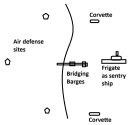Could you add enough armor everywhere to prevent this thing from being mission-killed by a modern subsonic Anti-Ship missile?
Who care if you can add armor if you can't add "enough" armor?
This discussion sounds like happening in Admiralty or Seekriegsleitung 100 years ago ...
Cost of production and duration of production will rise, and it will decrease speed to get to the LZ.
Adding armor will not help against an anti ship or even anti tank missile. It's also useless against artillery barrage since shrapnel doesn't work when hitting water and a direct hit is going to hurt regardless because it is such a big ship that you have to add a LOT of armor to make it practical useful.
Might as well just make more of these.
What they can add is some passive defense like laser dazzler or drone jammer but I suppose that PLAN is going to relegate that duty to other hardwares as it beaches.
Do none of you understand that modern blast-fragmentation warheads on anti-ship missiles are not designed to penetrate armor? Because modern warships are obviously not armored. Rather, they are designed for maximum damage to soft targets. Nobody puts armor on their ships anymore because simply redesigning the warhead will defeat it, and that's a lot easier than building ships. But if you armor just this one ship, a ship which is already far more difficult to mission-kill because it lacks sensitive electronics and sophisticated weapons of its own, then all of those anti-ship missiles will struggle to knock it out.
Anti-tank missiles are a different story since they are of course designed to penetrate armor. But those range of such missiles are literally orders of magnitude shorter, as is the size of their warheads and extent of damage they can deal, so there is a lot of value in forcing your enemy to make themselves more vulnerable to land a smaller hit.
Last edited:




